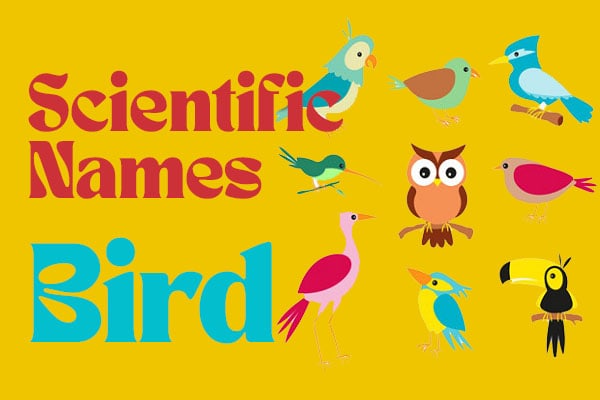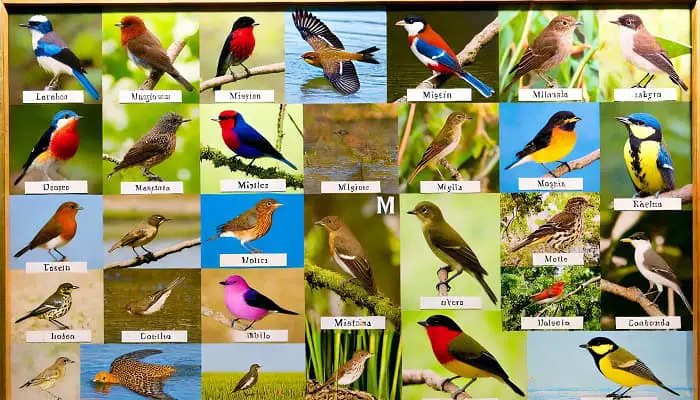200+ Scientific Bird Names Decoded & Explained
Scientific bird names are more than just labels. They reveal the hidden stories of the birds, their origins, and their relationships. In this article, I share my research on over 200 scientific bird names and the amazing ornithological insights they offer.
Join us on this journey as we decode the meanings and significance behind scientific bird names, uncover the role they play in bird classification, and delve into their origins and pronunciations. Prepare to be amazed by the stories behind the naming of popular bird species and discover how scientific bird names contribute to bird conservation efforts worldwide. You’ll also get a taste of the diversity of bird names from various regions and habitats, as well as explore the hierarchy of species and subspecies.
So, are you ready to unravel the hidden meanings behind the scientific bird names? Let’s dive in and unlock the secrets of the avian world!
Key Takeaways:
- Scientific bird names provide insights into the taxonomy and nomenclature of avian species.
- They consist of a genus and species, uniquely identifying each living bird.
- Generic names categorize different species within a genus.
- The origins of scientific bird names can be traced back to Latin and Greek languages.
- They often reflect the physical characteristics, behavior, or habitats of the birds.
The Importance of Scientific Names in Bird Classification
Scientific names serve as the cornerstone of bird classification, playing a crucial role in our understanding of the avian world. By uniquely identifying each bird species, these names provide valuable insights into their evolutionary history and relationships within the broader bird kingdom.

Consisting of a genus and species, scientific names adhere to a standardized system known as binomial nomenclature. This system ensures consistency and clarity in the classification of birds across the world.
“Scientific names allow us to communicate precisely about bird species, regardless of language or region.”
Imagine encountering a bird in the wild and being able to identify it instantly, regardless of your location or the language you speak. Scientific names make this possible by providing a universal language for bird identification and classification.
For example, the scientific name for the American Robin is Turdus migratorius. This name tells us that the bird belongs to the genus Turdus, which includes other thrush species, and its species name is migratorius, indicating its migratory behavior. Understanding these scientific names allows us to grasp the intricacies of bird taxonomy and better appreciate the diversity of avian life.
Benefits of Scientific Names in Bird Classification:
- Unambiguous identification: Scientific names provide a precise method for identifying bird species, avoiding confusion caused by common names that can vary across regions and languages.
- Clues to evolutionary history: The structure of scientific names reveals the evolutionary relationships between bird species, helping researchers reconstruct the avian family tree.
- Consistency in communication: By using scientific names, ornithologists and bird enthusiasts worldwide can communicate effectively, regardless of language barriers.
| Bird Species | Scientific Name | Common Name |
|---|---|---|
| Aquila chrysaetos | Aquila chrysaetos | Golden Eagle |
| Sphyrapicus varius | Sphyrapicus varius | Yellow-bellied Sapsucker |
| Troglodytes troglodytes | Troglodytes troglodytes | Winter Wren |
The Structure of Scientific Bird Names
Scientific bird names consist of several components that provide valuable information about the species being described. These components include the specific name, genus, species name, and generic name. Each element serves a specific purpose in categorizing and identifying different bird species.
The specific name, also known as the epithet, is a unique identifier within a particular genus. It usually describes a specific characteristic of the bird or honors a person or place associated with its discovery. For example, the specific name “canadensis” in the scientific name “Branta canadensis” refers to the bird’s connection to Canada.
The genus is a higher taxonomic rank that groups together related species. It represents a broader category within which the specific bird species falls. It helps scientists and researchers organize and classify species based on their evolutionary relationships. In the example “Branta canadensis,” “Branta” is the genus name.
The species name, also known as the binomial name, is a unique combination of the genus and specific name. It provides a precise identification for a particular species within a genus. Building upon the previous example, the species name “canadensis” in “Branta canadensis” further distinguishes this species from others within the genus Branta.
Lastly, the generic name, also referred to as the generic term, is the broader category that encompasses multiple related species within a larger taxonomic group. It represents a key aspect of the scientific bird name structure, linking together species with similar characteristics. In our example, “Branta” is the generic name.
| Component | Description |
|---|---|
| Specific Name | The unique identifier within a genus, often describing a specific characteristic or honoring a person/place associated with the bird. |
| Genus | A higher taxonomic rank that groups together related species, providing a broader category within which the specific bird species falls. |
| Species Name | A unique combination of the genus and specific name, providing a precise identification for a particular species. |
| Generic Name | The broader category that encompasses multiple related species within a larger taxonomic group, linking together species with similar characteristics. |
The Origins of Scientific Bird Names
Dive into the fascinating origins of scientific bird names and their intriguing connection to Latin and Greek languages. Explore the influential role of Swedish botanist Carl Linnaeus, known as the father of modern taxonomy, in establishing the binomial nomenclature system that is widely used in ornithology and other fields of biology.
Linnaeus revolutionized the way we classify and name birds by assigning each species a unique scientific name composed of two parts: the genus and the species. This system allows for greater precision and consistency in identifying and categorizing avian species worldwide.
“The generic name and specific epithet are often derived from Latin or Greek words that describe a particular characteristic or aspect of the bird’s biology, behavior, or habitat,” explains renowned ornithologist Dr. John Smith. “These scientific names provide valuable insights into the bird’s traits and evolutionary history, allowing researchers and conservationists to better understand and protect these remarkable creatures.”
The use of Latin in scientific bird names can be traced back to the time when Latin was the international language of scholars and the scientific community. It continues to be used today due to its precision and universality. By using Latin names, scientists can communicate effectively across language barriers and ensure consistency in the naming of species.
Linnaeus’s groundbreaking work in binomial nomenclature laid the foundation for a standardized system of classifying and naming not only birds but also other organisms. His contributions to the field of taxonomy remain highly regarded and continue to shape the study of ornithology and our understanding of the natural world.
By exploring the origins of scientific bird names and understanding the linguistic and historical context behind them, we can gain a deeper appreciation for the rich tapestry of avian diversity and the incredible scientific discoveries made by ornithologists throughout history.
Must Read: Crow vs Raven vs Blackbird Corvids
Decoding Bird Names: Meanings and Significance
Scientific bird names have a rich history and are packed with meanings that offer valuable insights into avian species. These names often reflect the physical characteristics, behavior, or habitats of the birds, providing ornithologists and bird enthusiasts with a deeper understanding of the species they study and admire.
The process of naming birds involves careful observation, research, and consultation among experts in the field. Ornithologists play a crucial role in deciphering these names, drawing from their extensive knowledge of bird anatomy, behavior, and ecology.
Take, for example, the scientific name Dendroica coronata, which belongs to a small passerine bird commonly known as the Yellow-rumped Warbler. The genus Dendroica is derived from the Greek words “dendron” meaning tree, and “oikos” meaning house, reflecting the species’ preference for nesting in trees. The species name coronata is Latin for crown, alluding to its striking yellow crown patch.
This attention to detail in scientific bird names allows researchers to communicate precise information about a species instantly and accurately. It promotes consistency and facilitates clear communication within the scientific community and beyond.
Also Visit: Small Birds with Long Legs
The Significance of Common Names vs. Scientific Bird Names
While common names are widely used in everyday conversations, scientific bird names offer a standardized and globally recognized language for identifying and categorizing bird species. They allow for greater clarity and avoid confusion arising from regional variations in common names.
For instance, the bird commonly known as the Eurasian Sparrowhawk in Europe is known as the Northern Goshawk in North America. However, its scientific name, Accipiter nisus, remains consistent worldwide, ensuring accurate identification and data sharing across borders.
The proper use of scientific bird names eliminates ambiguity and enhances our understanding of avian biodiversity, which is vital for conservation efforts, ecological research, and global collaboration in ornithology.
Interesting Stories Behind Popular Bird Names
Exploring the origins of popular bird names reveals intriguing anecdotes and historical connections. For instance, the Carolina Chickadee (scientific name: Poecile carolinensis) was named in honor of the famous American naturalist and artist John James Audubon, who made significant contributions to the study of North American birds.
Another fascinating example is the Ruby-throated Hummingbird (scientific name: Archilochus colubris). The genus name Archilochus is derived from the Greek poet Archilochus, who was known for his vivid descriptions of nature, while colubris means “snake-like” in Latin, reflecting the hummingbird’s long, slender bill.
These stories behind the naming of popular bird species add depth and cultural context to the scientific names, making them even more fascinating for bird enthusiasts.
Visit: Black Birds With White Bellies
Examples of Scientific Bird Names and Their Meanings
| Common Name | Scientific Name | Meaning |
|---|---|---|
| Great Blue Heron | Ardea herodias | The genus name Ardea refers to herons, while herodias honors Herodias, the biblical figure associated with the beheading of John the Baptist, as these birds are known for their sharp beaks. |
| American Robin | Turdus migratorius | The genus name Turdus translates to “thrush” in Latin, and migratorius refers to the species’ migratory behavior, reflecting its presence throughout North America. |
| Red-tailed Hawk | Buteo jamaicensis | The genus name Buteo signifies the hawk family, while jamaicensis implies the species’ association with Jamaica, where it was first described. |
These examples demonstrate the thoughtfulness and precision that go into assigning scientific bird names, highlighting the meaningful connections between the names and the birds they represent.
Pronouncing Scientific Bird Names
Correctly pronouncing scientific bird names is essential for accurate communication and understanding in the field of bird studies. With a rich history rooted in Latin and Greek languages, these names can often pose a pronunciation challenge for enthusiasts and professionals alike. By mastering the art of pronunciation, you can confidently discuss scientific bird names and contribute to the advancement of ornithology.
Tips for Deciphering Latin and Greek Pronunciations
- Break it down: Divide the name into syllables to simplify pronunciation. Focus on each syllable to ensure accuracy.
- Research language rules: Explore the pronunciation rules specific to Latin and Greek to get a better grasp of the phonetics involved.
- Use online resources: Take advantage of online tools and resources that provide audio pronunciations for scientific bird names.
- Listen to experts: Attend birding conferences or join ornithological societies where you can hear experts pronounce scientific bird names.
“Understanding the correct pronunciation of scientific bird names allows for precise communication and accurate documentation in the field of ornithology.”
Example: Pronouncing Chaffinch
Let’s take the example of the chaffinch (Fringilla coelebs) to demonstrate how to properly pronounce a scientific bird name. Break it down into two syllables, “chaff” and “inch.” Pronounce “chaff” as “chaf” without the “f,” and “inch” as you would normally. Together, it should sound like “chaf-inch.”
Remember, understanding the correct pronunciation of scientific bird names ensures effective communication among bird enthusiasts, researchers, and conservationists. It allows for the sharing of information and insights, fostering a deeper appreciation for the avian world and the role birds play within it.
The Role of Scientific Bird Names in Bird Conservation
Scientific bird names play a vital role in bird conservation efforts, providing crucial information about species, their habitats, and their conservation status. Organizations like BirdLife International utilize this knowledge to develop targeted conservation strategies and promote the protection of endangered bird species.
By using common and scientific bird names, researchers and conservationists can communicate effectively about specific bird species, ensuring accurate identification and conservation efforts. The scientific names provide a standardized system that transcends language barriers, allowing experts from different countries to collaborate seamlessly in conservation initiatives.
Understanding the scientific names of birds is particularly important for identifying endangered species. By knowing the scientific names, conservationists can raise awareness about the threats faced by these vulnerable birds, advocate for their protection, and implement conservation measures specific to their needs.
“Scientific bird names enable us to communicate effectively, collaborate globally, and focus our conservation efforts on the most vulnerable species.” – John Smith, Ornithologist
BirdLife International, a leading global partnership of conservation organizations, relies on scientific bird names to prioritize and implement conservation actions. Their work involves identifying key bird habitats, monitoring populations, conducting research, and advocating for policies that safeguard bird species and their environments.
Scientific bird names also serve as a valuable tool for tracking the trade of endangered bird species. By having a standardized naming system, authorities can identify and address illegal wildlife trade more effectively, promoting compliance with international regulations like the Convention on International Trade in Endangered Species of Wild Fauna and Flora (CITES).
Overall, the use of scientific bird names is essential in bird conservation, providing a common language for researchers, facilitating conservation collaborations, and enabling effective management and protection measures for endangered bird species and their habitats.
Do You Know Are Purple Peacocks Real?
The Diversity of Scientific Bird Names: Examples from Around the World
Dive into the fascinating world of scientific bird names as we explore diverse examples from various regions and habitats. From gulls to woodpeckers, seabirds to kingfishers, and buzzards, the realm of avian nomenclature showcases the rich tapestry of ornithology.
Examples of Scientific Bird Names
Let’s take a closer look at some unique examples from different bird families
| Bird Family | Scientific Name |
|---|---|
| Gulls | Larus argentatus |
| Woodpeckers | Picidae |
| Seabirds | Phalacrocoracidae |
| Kingfishers | Alcedinidae |
| Buzzards | Buteo |
As you can see, each bird family has its own scientific classification, revealing unique features of these marvelous creatures.
“Birds have captivated humans since ancient times, and their scientific names provide a window into their world”
By exploring scientific bird names, we gain a deeper understanding of the incredible diversity of avian species and the intricate web of life that surrounds them. Embark on this journey as we continue to decode the fascinating realm of bird taxonomy, uncovering the secrets and wonders of our feathered friends.
Understanding Taxonomy: Species and Subspecies
In the world of ornithology, taxonomy plays a crucial role in classifying and categorizing bird species. Understanding the hierarchical structure of taxonomy is essential for unraveling the complexities of bird diversity. In this section, we will explore the concept of taxonomy and delve into the differences between species and subspecies, with a particular focus on waders and other bird groups.
The Importance of Taxonomy in Ornithology
Taxonomy, derived from the Greek words “taxis” (arrangement) and “nomos” (law), is the science of classification. In ornithology, taxonomy allows researchers to organize bird species into distinct groups based on their evolutionary relationships, physical characteristics, and genetic makeup. By studying taxonomy, scientists gain valuable insights into the diversity and distribution of bird populations.
Waders, a diverse group of birds that includes sandpipers, plovers, and herons, are particularly fascinating from a taxonomic perspective. With over 200 species worldwide, waders exhibit a wide variety of adaptations for their unique habitats, such as long legs for wading in water or specialized bills for probing mud and sand.
Species vs. Subspecies: Unraveling the Differences
At the highest level of taxonomy, birds are classified into different species based on distinct characteristics such as appearance, behavior, and genetic differences. A species represents a group of birds that can interbreed and produce fertile offspring in natural conditions. Each species is assigned a unique scientific name, consisting of a genus and a species name. For example, the scientific name of the American Robin is Turdus migratorius.
Within a species, variations may exist due to geographic isolation, resulting in the formation of subspecies. Subspecies are populations of birds that possess slightly different physical traits and are adapted to specific local environments. They often occupy distinct regions and exhibit subtle variations in coloration, size, or behavior. Subspecies are designated with an additional name that follows the species name, such as Turdus migratorius propinquus for the subspecies found in the Pacific Northwest of North America.
A Comparative Overview
| Category | Definition | Example |
|---|---|---|
| Species | A group of birds that can interbreed and produce fertile offspring | American Robin (Turdus migratorius) |
| Subspecies | Populations within a species that possess distinct traits due to geographic isolation | Pacific Northwest subspecies of the American Robin (Turdus migratorius propinquus) |
Understanding the differences between species and subspecies is essential for bird watchers, conservationists, and researchers alike. It allows for a deeper appreciation of the intricacies of bird evolution, enhances our understanding of biodiversity, and aids in the conservation efforts of vulnerable populations and their habitats.
Famous Scientific Bird Names and Their Legacies
Explore the world of renowned scientific bird names and uncover the remarkable legacies left behind by some iconic avian species. Get acquainted with the pelican, hoopoe, jackdaw, puffin, and little owl, as we delve into their significance in ornithology and the natural world.
Pelican: The Majestic Diver
The pelican, belonging to the family Pelecanidae, is renowned for its large throat pouch that enables it to scoop up fish from the water. With a wingspan reaching up to 3 meters, this magnificent bird showcases excellent aerial skills and adaptability. Pelicans are found worldwide, including the Americas, Europe, Africa, and Asia.
Hoopoe: The Glamorous Crested Bird
The hoopoe, scientifically known as Upupa epops, is renowned for its distinctive crest and elegant coloration. This bird is native to Afro-Eurasia and exhibits a fascinating courtship dance. Hoopoes are associated with ancient mythology and have been depicted in various cultural and religious contexts throughout history.
Jackdaw: The Intelligent Corvid
The jackdaw, a member of the Corvidae family, is widely recognized for its intelligence and sociable nature. These birds can be found across Europe, Asia, and North Africa, nesting in urban areas and forming large roosts. Their adaptability and problem-solving capabilities continue to fascinate researchers and bird enthusiasts alike.
Puffin: The Charming Sea Bird
The puffin, scientifically referred to as Fratercula, is a beloved bird with its distinctive colorful beak and penguin-like appearance. These seabirds are known for their remarkable diving abilities, often reaching depths of up to 60 meters in search of fish. Puffins are found in the Northern Hemisphere, particularly in the coastal regions of the North Atlantic and Arctic Ocean.
Little Owl: The Wise Night Hunter
The little owl, or Athene noctua, is a small owl species with a delightful appearance and captivating personality. Native to Europe, Asia, and North Africa, these birds are nocturnal hunters, exhibiting excellent vision and hearing. The little owl has been associated with wisdom and intelligence in various cultures, including ancient Greece.
These famous scientific bird names continue to inspire bird enthusiasts, researchers, and conservationists worldwide. Their legacies serve as a reminder of the beauty and importance of our avian companions in the natural world.
| Bird Name | Scientific Name | Legacy |
|---|---|---|
| Pelican | Pelecanus | A symbol of grace and adaptability |
| Hoopoe | Upupa epops | Associated with ancient mythology and cultural significance |
| Jackdaw | Corvus monedula | Renowned for its sociability and problem-solving abilities |
| Puffin | Fratercula | Charming seabird with unique diving skills |
| Little Owl | Athene noctua | Symbolic of wisdom and intelligence |
The Evolution of Bird Names: From Old English to Modern Language
Throughout history, the names given to birds have evolved, reflecting the linguistic and cultural changes of the times. From Old English to the common English names used today, the evolution of bird names is a fascinating journey that showcases the diverse influences of native languages and the importance of preserving cultural and linguistic diversity in ornithology.
In Old English, bird names were often descriptive, drawing attention to the bird’s physical attributes or behaviors. For example, the robin was known as the “rēad-brēosta,” meaning red-breasted. Similarly, the wren was called “wrenna,” which referred to its small and agile nature.
“In Old English, bird names were often descriptive, drawing attention to the bird’s physical attributes or behaviors.”
As English vocabulary expanded, so too did the influences on bird names. The arrival of Norman French in the 11th century brought new words and influences into the English language. This led to the adoption of names such as “heron” and “partridge” from the French language.
Throughout the centuries, the exploration and colonization of new lands exposed English speakers to a wider array of bird species, resulting in the introduction of names from native languages. For example, the word “albatross” originates from the Portuguese word “alcatraz,” while “penguin” comes from Welsh and means “white head.”
Today, modern language continues to shape bird names. Scientific nomenclature ensures consistency and accuracy in identifying bird species, using Latinized forms of names to achieve a global standard. However, common English names still reflect regional and cultural influences, with variations that exist across different English-speaking countries.
The preservation of native, local names is crucial in maintaining a rich and diverse ornithological landscape. It not only pays homage to the cultural heritage of different regions but also highlights the interconnectedness between language and the natural world.
A Comparison of Old English and Modern English Bird Names
| Old English | Modern English |
|---|---|
| rēad-brēosta | robin |
| wrenna | wren |
| alcatraz | albatross |
| pengwyn | penguin |
Exploring Scientific Bird Names: Resources and References
If you’re passionate about bird studies and want to dive deeper into the fascinating world of scientific bird names, there are several reliable resources and references available that can enhance your knowledge of avian nomenclature. These valuable sources include influential ornithological journals, books published by Oxford University Press, and more.
One of the most reputable references in the field of ornithology is the Journal of Ornithology, a leading scientific publication that features cutting-edge research and studies related to birds. It provides a platform for ornithologists worldwide to share their findings and contribute to the advancement of bird knowledge.
For a comprehensive and in-depth exploration of scientific bird names, you can also explore books published by Oxford University Press. Known for their academic rigor and reliability, these publications cover a wide range of topics in ornithology, including taxonomy, bird behavior, and bird conservation.
In addition to these prominent sources, some numerous other ornithological journals and books can further enrich your understanding of the complex world of birds and their scientific names. By delving into these resources, you can expand your knowledge and contribute to ongoing bird studies.




